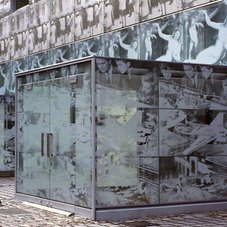 Artists,Tom Mullaney and Andrea Ackerman's loft in Williamsburg; table constructed by Mullaney with recycled plastic lumber. Is recycled plastic lumber a sustainable strategy? Certainly as a material, it out performs wood in terms of maintenance and composed of "renewable" resource, if one considers plastic recycling a resource.
Artists,Tom Mullaney and Andrea Ackerman's loft in Williamsburg; table constructed by Mullaney with recycled plastic lumber. Is recycled plastic lumber a sustainable strategy? Certainly as a material, it out performs wood in terms of maintenance and composed of "renewable" resource, if one considers plastic recycling a resource.Yesterday ecomodista obtained an estimate to remove the asphalt parking lot at our apartment compound because it is a massive heat sink, essentially an environment that absorbs and dissipates radiant (the sun) heat. The visible vapor above an asphalt road in the summer perfectly illustrates this issue. To implement sustainable concepts for our adobe apartment compound, we are first tackling the low tech solutions, such as asphalt removal.
Asphalt surrounds our cities, and if in the summer, the temperature in New York City was measured in midtown, rather than Central Park, there would be an increase of 10 to 15 degrees F. Asphalt is not only used for highways, as ecomodista discovered to her dismay when she purchased adobe blocks, torrones, from a vendor in the North Valley in Albuquerque. Most adobe bricks are stabilized, generally by mixing a small percentage of concrete into the mud. Hybrid adobe is also being explored, and is a great way to recycle weeds and garden cuttings. This would not affect degradation resulting from exposure to water, which is why most adobes are stabilized. For reference see: http://www.hybridadobe.com/how_to.shtml
ecomodista bought adobes for repairs in one of the units, and intended to order a truckload to rebuild the horno (adobe oven used by indigenous people for baking bread or firing pottery). When told that the bricks were stabilized with asphalt, she inquired about non-stabilized adobes, and the vendor remarked that he made these only in May and June when women from the Pueblos bought them for their hornos. He scoffed at the idea that these women found bread baked in hornos constructed from stabilized adobe tasted like a petrochemical.
Asphalts are bituminous materials which occur naturally or are derived from nondestructive separation of petroleum fractions. Typically, this is achieved through fractional distillation or solvent de-asphalting. Asphalt should not be confused with tar, which is obtained through destructive processing of coal, wood, or petroleum. Asphalt contains aliphatic hydrocarbons in addition to the mononuclear aromatics and polycyclic aromatic hydrocarbon (PAH) mixtures found in asphalt & tar.
The National Park Service, Water Resources Division, has published an Encyclopedia of Contaminants by Irwin, R.J., M. VanMouwerik, L. Stevens, M.D. Seese, and W. Basham which contains the following information:
"The primary hazard associated with asphalt arises from PAHs and alkyl PAHs in asphalt that can move into the ecosystem from the breakdown of asphalt. Since asphalt contains so many toxic and carcinogenic compounds and since leaching of harmful PAH compounds has been documented even in water pipe use, asphalt should be kept out of rivers, streams, and other natural waters to the extent possible NIOSH urges caution related to human exposure to asphalt. Current NIOSH research indicates that asphalt products are carcinogenic to laboratory animals and, therefore may be more toxic to humans than previously believed [366]. Air concentrations of PAHs have been shown to increase to potentially dangerous levels in National Parks in response to forest fires and asphalt roads burned by lava flows; although the human health risks from low levels of PAHs is not precisely known, the National Institute of Occupational Safety and Health position is that any exposure to certain carcinogenic PAHs is too much and therefore the exposure should be limited as much as possible."
After reading this information and other research, ecomodista's decision to remove the asphalt is confirmed, and the asphalt that is removed can be recycled, although the consumer pays for recycling. Gravel and red crushed rock will replace the asphalt, preventing flooding, and allowing precipitation to reach the aquifer under Albuquerque.







